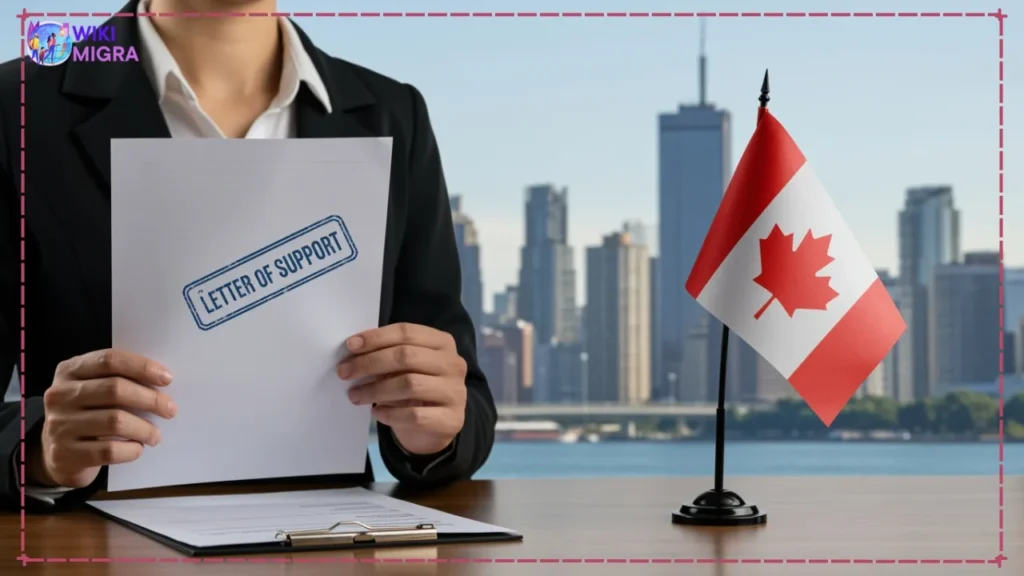Canada Startup Visa Letter of Support: 7 Steps to Get Yours Approved in 2025

Trying to build a startup in Canada? You’ll need one key document to unlock the doors of opportunity: the Canada Startup Visa letter of support. Without it, your visa application can’t even begin.
Let me show you:
- 🔑 How to get letter of support Canada Startup Visa
- 🏢 Which designated organizations Canada Startup Visa trusts
- ✅ What the Startup Visa Canada support letter requirements are
- 💡 How to create a winning pitch deck that grabs attention
- ⏱️ What happens after you secure your support letter
Get ready—this is your complete guide to securing a letter of support for Canada Startup Visa success.
You may be interested in: Canada Start Up Visa Program: The Ultimate Guide for Entrepreneurs (2025)
What Is a Canada Startup Visa Letter of Support?

A Canada Startup Visa letter of support is an official document provided by a designated organization in Canada—such as a venture capital fund, angel investor group, or business incubator.
This letter proves that your startup has been reviewed and accepted by one of these organizations, and it’s mandatory for your Startup Visa application.
Without this letter, you’re not eligible to apply. It’s the backbone of your visa journey.
Designated Organizations Canada Startup Visa Relies On
There are over 60 approved designated organizations Canada Startup Visa recognizes. These are divided into:
| Organization Type | Requirement |
|---|---|
| Venture Capital Funds | Invest $200,000+ in your startup |
| Angel Investor Groups | Invest $75,000+ |
| Business Incubators | Accept you into their program |
Examples include:
- Creative Destruction Lab (CDL)
- Techstars Toronto
- Highline Beta
- NEXT Canada
- Empowered Startups
Choosing the right designated organization is critical to getting your Startup Visa Canada letter of support approved.
How to Get Letter of Support Canada Startup Visa: Step-by-Step

Here’s the playbook:
- Identify your ideal designated organization
- Research which ones align with your sector (AI, FinTech, HealthTech, etc.)
- Tailor your pitch
- Make it personalized—don’t just send the same PDF to everyone.
- Submit your application
- Include your pitch deck, business plan, team bios, and proof of concept.
- Engage in follow-up
- Many organizations will request interviews, Q&A, or updates.
- Receive a Letter of Support
- If approved, they’ll issue your Canada Startup Visa letter of support, and submit a Commitment Certificate to IRCC.
💡 Pro tip: Always double-check the organization’s current acceptance process on their website. Some only accept startups during accelerator cycles.
Startup Visa Canada Support Letter Requirements
To meet the Startup Visa Canada support letter requirements, here’s what you’ll need:
- A viable, scalable business model
- Strong founding team with relevant experience
- Proof of market validation or traction
- Clearly defined go-to-market strategy
- Alignment with Canada’s economic goals
The letter of support for Canada Startup Visa will only be issued if your startup shows clear innovation, economic potential, and growth capacity in the Canadian market.
How to Impress Designated Organizations Canada Startup Visa Approves
These organizations receive hundreds of pitches monthly. Here’s how to stand out:
- 📊 Use data: Show early traction, revenue, or user growth.
- 🎯 Be specific: Don’t just say “we solve a big problem”—explain how.
- 🤝 Show commitment: Mention your readiness to relocate and contribute to Canada’s innovation economy.
- 🌱 Highlight sustainability: Canada loves green tech and social innovation.
Sample Pitch Deck That Secured a Canada Startup Visa Letter of Support
Want to see what works? Here’s the 10-slide formula:
- Problem
- Solution
- Target Market
- Product Overview
- Business Model
- Market Strategy
- Traction/Metrics
- Competitive Advantage
- Team
- Ask (funding or incubation)
Make sure your deck aligns with the values of the designated organizations Canada Startup Visa respects—clarity, innovation, and global potential.
Common Mistakes That Sabotage Your Support Letter

Avoid these traps:
- ❌ Sending mass emails without customization
- ❌ Over-promising results with no evidence
- ❌ Ignoring pitch deck best practices
- ❌ Not aligning your solution with Canadian industries
- ❌ Not showing how your team can execute
Remember, getting the Canada Startup Visa letter of support is as much about the founders as the idea itself.
Real Success Stories of Startup Visa Canada Letter of Support
| Entrepreneur | Sector | Organization | Result |
|---|---|---|---|
| Zain, UAE | FinTech | Techstars Toronto | $125K seed funding + PR |
| Maria, Brazil | EdTech | NEXT Canada | Accepted into accelerator |
| Liam, UK | CleanTech | CDL | $200K VC + mentorship |
Each of these startups met the exact Startup Visa Canada support letter requirements and built strong, Canada-relevant business cases.
What Happens After You Get the Letter of Support?
You’re halfway there! Once your Canada Startup Visa letter of support is secured:
- IRCC receives a Commitment Certificate from the organization
- You submit your Startup Visa application online
- Biometrics and medicals follow
- PR is processed in approx. 12–16 months
While you wait, many founders start working remotely with Canadian clients or partners—setting the stage for future success.
Legal Tips: Do You Need an Immigration Consultant?
Not required—but recommended if:
- English isn’t your first language
- You’re not confident with the online IRCC process
- You need help identifying the right designated organization
Look for ICCRC-licensed professionals only.
Why the Canada Startup Visa Program Is a Global Magnet
Canada’s Startup Visa is one of the most founder-friendly immigration programs in the world. Why?
- 🧠 No minimum net worth requirement (unlike investor visas)
- 🌍 Permanent Residency for up to 5 co-founders
- 🇨🇦 Access to Canada’s world-class startup ecosystem
- 🏥 Universal healthcare and public education
- 💵 Growing VC and angel investment scene
It’s the gateway to both entrepreneurial and personal growth.
How to write a letter of support for a Canada visa?
Writing a letter of support for a Canada visa is an important task that can significantly influence the success of the applicant’s visa application. This letter, often referred to as a “letter of invitation” or “visa support letter,” provides immigration authorities with additional context about the applicant’s visit, their relationship with the host, and assurances regarding their stay in Canada. Below is a detailed step-by-step guide on how to write this letter effectively.
Step 1: Understand the Purpose of the Letter
The purpose of a letter of support for a Canada visa is to:
- Provide evidence that the applicant has genuine reasons for visiting Canada.
- Confirm that they have ties to their home country and will return after their visit.
- Offer details about accommodations, financial arrangements, and other logistics during their stay.
- Reassure Canadian immigration authorities that the visitor will comply with Canadian laws and visa conditions.
This letter does not guarantee visa approval but serves as supplementary documentation to strengthen the application.
Step 2: Gather Essential Information
Before drafting the letter, collect all necessary details about both yourself (the host) and the visitor (the applicant). These include:
Information About Yourself (Host):
- Full name.
- Date of birth.
- Address in Canada.
- Telephone number and email address.
- Citizenship or immigration status in Canada (e.g., Canadian citizen or permanent resident).
- Include proof such as:
- A photocopy of your Canadian passport or citizenship certificate if you are a citizen.
- A copy of your Permanent Resident (PR) card or IMM 1000 document if you are a permanent resident.
- Include proof such as:
- Occupation and job title.
- Details about your family members (if relevant).
Information About the Visitor (Applicant):
- Full name.
- Date of birth.
- Address and telephone number in their home country.
- Relationship to you (e.g., friend, family member, colleague).
- Purpose of their trip to Canada (e.g., tourism, attending an event, visiting family).
- Duration of stay in Canada (specific dates preferred).
- Where they will stay during their visit (your residence or elsewhere).
- How they will pay for expenses during their trip.
Step 3: Structure Your Letter
A well-organized structure ensures clarity and professionalism. Follow this format:
1. Introduction
Begin by introducing yourself and explaining your relationship with the applicant. Include basic personal information such as your full name, address in Canada, citizenship/immigration status, and occupation.
Example:
My name is John Smith. I am a Canadian citizen residing at 123 Maple Street, Toronto, Ontario. I work as an accountant at XYZ Corporation. I am writing this letter to invite my cousin, Jane Doe, who resides in London, United Kingdom, to visit me in Canada from June 15th to July 15th, 2025.
2. Purpose of Visit
Clearly state why the applicant is visiting Canada. Be specific about activities planned during their stay.
Example:
The purpose of Jane’s visit is to spend time with family and explore some tourist attractions in Toronto and Vancouver. During her stay, we plan to visit landmarks such as Niagara Falls and Stanley Park.
3. Financial Responsibility
Indicate whether you will be financially supporting the visitor during their trip or if they will cover their own expenses. If applicable, provide details about accommodations.
Example:
Jane will be staying at my residence throughout her visit at no cost. I will also cover her daily expenses including food and transportation while she is here.
If they are self-funded:
Jane has sufficient funds to cover her travel expenses independently. She has provided evidence of her financial stability through bank statements included with her application.
4. Assurance
Reassure immigration authorities that the visitor intends to abide by Canadian laws and return home after their visit.
Example:
Jane has strong ties to her home country where she works as a teacher at ABC School. She has already arranged leave from work for this trip and plans to return immediately after her vacation on July 15th.
5. Closing Statement
Conclude by reiterating your support for the applicant’s visa application and offering further assistance if needed.
Example:
In conclusion, I fully support Jane Doe’s application for a Temporary Resident Visa to visit Canada. Please do not hesitate to contact me at [phone number] or [email address] if you require any additional information or documentation.
Step 4: Attach Supporting Documents
To strengthen your letter’s credibility:
- Include copies of documents proving your legal status in Canada (e.g., passport photo page or PR card).
- If applicable, attach evidence related to accommodations or financial arrangements.
Step 5: Sign and Date
End your letter with your signature followed by your full name typed below it along with the date written out clearly.
Example:
Sincerely,
John Smith
April 24th, 2025
Tips for Writing an Effective Letter
- Be Honest: Provide truthful information; misrepresentation can lead to legal consequences.
- Use Professional Language: Maintain formal tone throughout while being clear and concise.
- Proofread: Check for grammatical errors before submitting it alongside other visa documents.
In summary, writing a strong letter of support involves providing accurate personal details about both parties involved while addressing key aspects like purpose of travel, financial responsibility, accommodation plans, and assurance regarding compliance with Canadian immigration laws.
Sources:
- Immigration Refugees & Citizenship Canada – Letter of Invitation Guide [Canada.ca]
- Global Conference – Writing Visa Support Letters [GlobalConference.ca]
- Manifest Law – Immigration Letters [ManifestLaw.com]
What is the success rate of startup visa in Canada?
The success rate of the Start-Up Visa (SUV) program in Canada is approximately 77.2%, based on data from Immigration, Refugees and Citizenship Canada (IRCC) for the period between January 2023 and November 2023. During this time, IRCC processed a total of 3,334 applications for permanent residence under the SUV program. Out of these, 2,577 applications were approved, while 490 were refused, and 267 applications were withdrawn.
Breakdown of Statistics:
- Total Applications Processed: 3,334
- Approved Applications: 2,577
- Refused Applications: 490
- Withdrawn Applications: 267
This results in an approval rate of approximately 77.2%, which represents the proportion of successful applicants who obtained permanent residency through the SUV program.
Historical Context:
The success rate has been relatively consistent over recent years, with historical averages ranging between 75% and 80% since the program’s inception in 2013. However, there have been fluctuations due to factors such as changes in application volumes, processing backlogs, and stricter scrutiny by IRCC officers.
Factors Influencing Success Rates:
Several factors contribute to whether an applicant succeeds under the SUV program:
- Quality of Business Plan: A well-developed business plan that demonstrates innovation and scalability is critical.
- Support from Designated Organizations: Securing a Letter of Support from a designated organization (venture capital fund, angel investor group, or business incubator) significantly impacts approval chances.
- Progress Updates to IRCC: Applicants must regularly update IRCC about their start-up’s progress to demonstrate commitment and viability.
- Peer Reviews: IRCC may request peer reviews to ensure compliance with industry standards and prevent fraud.
Recent Challenges:
In early 2023 (January to April), approval rates temporarily dropped to around 51%, reflecting increased scrutiny by IRCC officers on business progress and intent. This emphasizes the importance of maintaining transparency and demonstrating tangible progress during the application process.
Conclusion: While the overall success rate remains high at around 77.2%, applicants must meet all eligibility criteria, secure strong backing from designated organizations, and actively work on their start-ups during the application process to maximize their chances of success.
How do I prove financial support for a Canadian visa?
To prove financial support for a Canadian visa, you must provide verifiable documentation that demonstrates you have sufficient funds to cover your expenses during your stay in Canada. This includes living costs, tuition fees (if applicable), and return transportation. The exact requirements depend on the type of visa you are applying for, such as a study permit, visitor visa, or immigration under programs like Express Entry. Below is a detailed step-by-step guide on how to prove financial support for a Canadian visa:
1. Understand the Financial Requirements
The amount of money required depends on the purpose of your visit and whether family members will accompany you:
- For Study Permits: As of January 1, 2024, international students must show proof of at least CAD 20,635 per year for living expenses (excluding tuition). For each accompanying family member, an additional CAD 4,000 is required for the first dependent and CAD 3,000 for each subsequent dependent.
- For Visitor Visas: You must demonstrate sufficient funds to cover living expenses during your stay in Canada. Generally, this is around CAD 10,000 per person for six months.
- For Immigration Programs (e.g., Express Entry): Proof of settlement funds varies based on family size. For example, a single applicant needs approximately CAD 13,757 as of recent updates.
2. Types of Acceptable Proof
You can use one or more of the following documents to prove financial support:
A. Bank Statements
Provide bank statements from the past four to six months that clearly show:
- Your name and account number.
- Consistent account activity (deposits and withdrawals).
- A balance that meets or exceeds the minimum required amount. Avoid large unexplained deposits; if they exist, include an explanation with supporting documents.
B. Guaranteed Investment Certificate (GIC)
A GIC is a secure investment option offered by Canadian banks specifically for international students. It guarantees both the principal amount and interest over time. Many students use GICs as proof because they are reliable and recognized by Immigration Refugees and Citizenship Canada (IRCC).
C. Proof of Tuition and Housing Payments
If you’ve already paid tuition fees or housing costs in advance:
- Provide receipts or official confirmation from your school or landlord. This reduces the total amount you need to show as available funds.
D. Employment Letters or Pay Stubs
If you’re employed:
- Submit an employment letter detailing your position, salary, and length of employment. Include recent pay stubs (typically from the last three months) to demonstrate consistent income.
E. Scholarship or Sponsorship Letters
If someone else is funding your trip:
- Include their financial documents (e.g., bank statements) along with a signed sponsorship letter explaining their relationship to you and their commitment to covering your expenses. If funded by a scholarship or government program:
- Provide official letters confirming the amount awarded.
F. Proof of Assets
Assets such as property ownership or investments can supplement liquid funds if they are easily convertible into cash:
- Include appraisals or income statements related to these assets.
3. Specific Requirements Based on Visa Type
A. Study Permit Applicants
International students must submit proof that covers:
- Tuition fees for at least one year.
- Living expenses (CAD 20,635 annually).
- Return transportation costs.
Acceptable documents include bank statements showing sufficient savings or GICs issued by participating Canadian banks like RBC or TD Bank. If parents are funding your education, include their employment details and savings records.
B. Visitor Visa Applicants
Visitors need enough funds to cover accommodation, food, travel within Canada, and return airfare:
- Submit evidence such as personal bank statements showing at least CAD 10,000 for six months. If staying with relatives in Canada who will sponsor you financially:
- Provide their financial documents along with an invitation letter.
C. Express Entry Applicants
Applicants under programs like Federal Skilled Worker Program must meet settlement fund requirements based on family size:
| Family Members | Required Funds |
|---|---|
| 1 | CAD 13,757 |
| 2 | CAD 17,127 |
| Each Additional Member | +CAD ~3,560 |
Funds must be readily accessible upon arrival in Canada; real estate equity cannot be used.
4. Tips for Strengthening Your Application
- Provide Multiple Documents: Use several types of proof (e.g., bank statements + GIC + sponsorship letters) to strengthen credibility.
- Explain Large Transactions: If there are unusual deposits in your account history (e.g., inheritance), attach supporting evidence like legal documents.
- Show Financial Stability: Demonstrate consistent income sources through pay stubs or business revenue reports if self-employed.
- Convert Foreign Currency: Clearly indicate equivalent amounts in Canadian dollars using up-to-date exchange rates.
Common Mistakes to Avoid
- Submitting incomplete bank statements without clear account activity.
- Providing outdated documents older than six months.
- Failing to explain large deposits adequately.
- Relying solely on personal loans as proof—these are generally not accepted unless explicitly stated otherwise.
- Ignoring currency conversion when submitting foreign bank accounts.
To prove financial support for a Canadian visa application: gather comprehensive documentation such as recent bank statements showing sufficient balances; consider using GICs; provide receipts for prepaid tuition/housing; submit employment letters/pay stubs; include sponsorship/scholarship letters if applicable; and ensure all amounts meet IRCC’s minimum requirements based on visa type and family size while avoiding common mistakes like unexplained transactions or incomplete records.
By following these steps carefully and providing robust evidence tailored to your specific visa category’s requirements, you can significantly improve your chances of approval.
How to get poe letter in Canada?
To get a Port of Entry (POE) letter in Canada, you must apply online for a study permit, work permit, or super visa through Immigration, Refugees and Citizenship Canada (IRCC). Once your application is approved and if you provided an email address during the application process, the POE letter will be issued to your IRCC account. You can download it from there.
Conclusion: Your Future in Canada Starts with One Letter
Securing your Canada Startup Visa letter of support isn’t just about filling out a form—it’s about proving your value to one of the most innovative economies on the planet.
So:
- Research the best designated organizations Canada Startup Visa offers.
- Tailor your pitch with laser focus.
- Know the Startup Visa Canada support letter requirements.
- Be bold. Be brilliant. Be Canadian.
FAQs
Q: Can I apply to more than one designated organization at a time?
A: Yes, but be strategic. Customize your approach. Sending mass emails to all of them is a quick way to get ignored.
Q: What if my startup is still pre-revenue?
A: That’s okay—many organizations care more about the team and potential than current earnings. Focus on traction, validation, and vision.
Q: How long is the Canada Startup Visa letter of support valid?
A: It’s valid for 6 months from the date it’s issued. Make sure you submit your application to IRCC before it expires.
Key Takeaways
Your startup dreams are possible—with strategy, hustle, and the right guidance.
The Canada Startup Visa letter of support is the gateway to startup immigration.
You must partner with designated organizations Canada Startup Visa has approved.
To get the letter, understand the support letter requirements, nail your pitch, and show Canadian relevance.
Avoid common mistakes—this isn’t just paperwork, it’s partnership.




